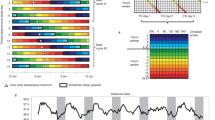Abstract
Several bodily functions in humans vary on a 24 h pattern and most of these variations persist with a circadian period ofca 25 h when subjects are studied under conditions of social and temporal isolation. We report in this paper that the estimates of short time intervals (TE) of 2 h are strongly coupled to the circadian rhythm in sleepwakefulness. There is a linear correlation between the number of hours humans stay awake (α) and their estimation of 2 h intervals. The coupling of TE to α appears to obtain only under conditions of physical well-being.
Similar content being viewed by others
References
Arendt J, Minors D S and Waterhouse J M 1989Biological rhythms in clinical practice (London: Wright)
Aschoff J 1985 On the perception of time during prolonged temporal isolation;Human Neuwbiol. 4 41–52
Aschoff J 1990 Interdependence between locomotor activity and duration of wakefulness in humans during isolation;Experientia 46 870–871
Aschoff J and Wever R 1976 Human circadian rhythms: A multioscillator system;Federation Proc. 35 2326–2332
Aschoff J and Wever R 1981 The circadian system of man; inHandbook of behavioral neurobiology. Biological rhythms (ed.) J Aschoff (New York: Plenum Press) vol 4, pp 311–331
Bünning 1973The Physiological clock (London: English University Press)
Chandrashekaran M K, Geetha L, Marimuthu G, Subbaraj R, Kumarasamy P and Ramkumar M S 1991 The menstrual cycle in human female under social and temporal isolation is not coupled to the circadian rhythm is sleep-wakefulness;Curr. Sci. 60 703–705
Konopka R J and Benzer S 1971 Clock mutants ofDrosophila melanogaster;Proc. Natl. Acad. Sci. USA 68 2112–2116
Kyriacou C P and Hall J C 1980 Circadian rhythm mutations inDrosophila melanogaster affect shortterm fluctuations in the male’s courtship song;Proc. Natl. Acad. Sci. USA 77 6729–6733
Minors D S and Waterhouse J M 1981Circadian rhythms and the human (London: Wright)
Wever R 1975 The circadian multioscillator system of man;Int. J. Chronobiol. 3 19–55
Wever R 1979The circadian system of man (New York: Springer)
Yu Q, Colot C V, Kyriacou C P, Hall J C and Rosbash M 1987 Behaviour modifications by invitro mutagenesis of a variable region within the period gene ofDrosophila;Nature (London) 326 1082–1083
Author information
Authors and Affiliations
Rights and permissions
About this article
Cite this article
Chandrashekaran, M.K., Marimuthu, G., Subbaraj, R. et al. Direct correlation between the circadian sleep-wakefulness rhythm and time estimation in humans under social and temporal isolation. J Biosci 16, 97–101 (1991). https://doi.org/10.1007/BF02703361
Received:
Revised:
Issue Date:
DOI: https://doi.org/10.1007/BF02703361




